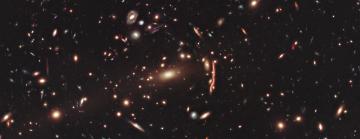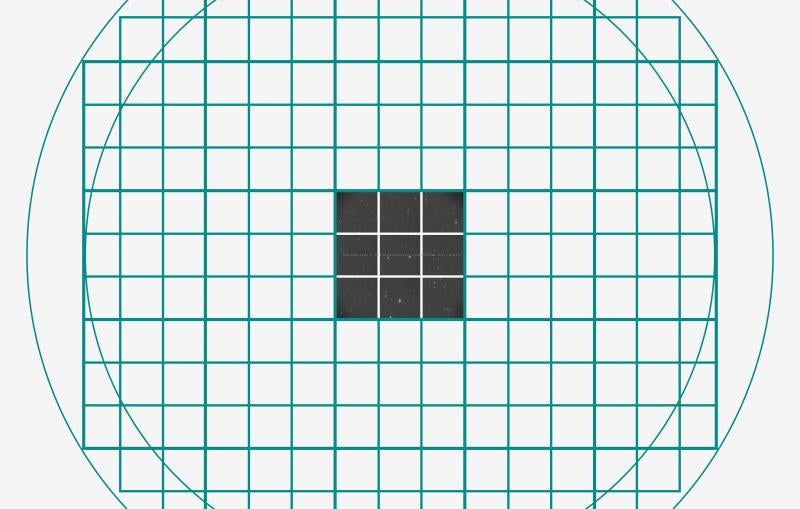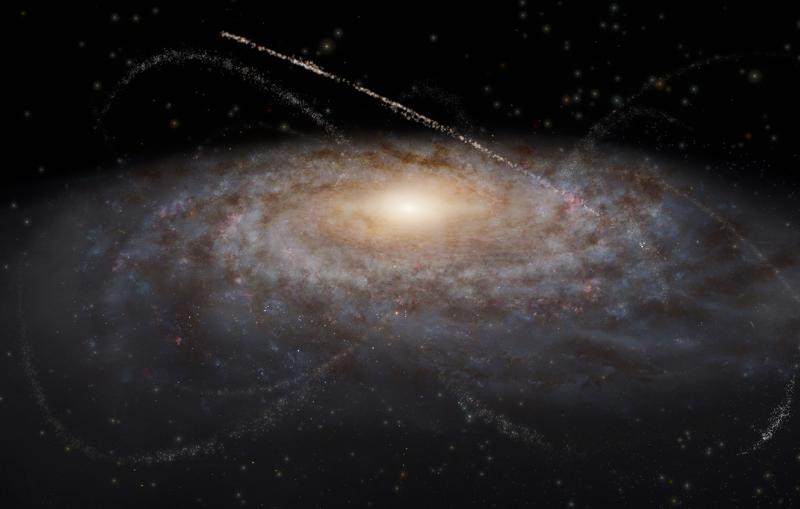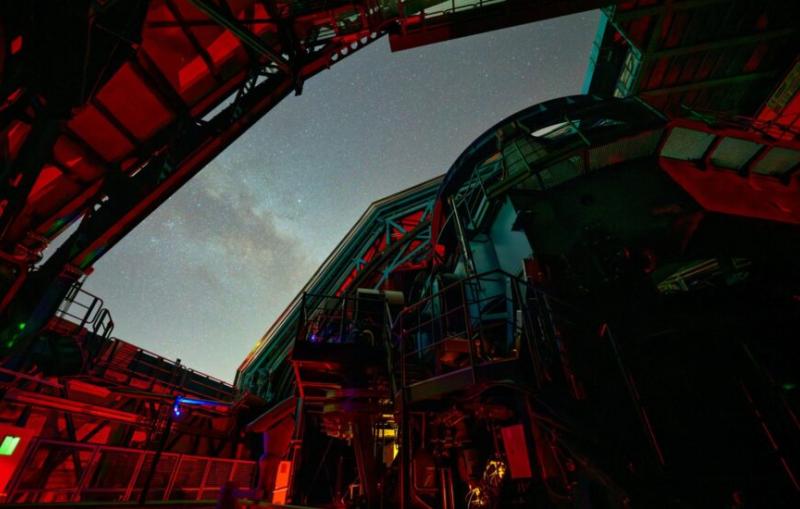KIPAC’s future is bright – and full of data
As the SLAC-Stanford institute celebrates its 20th anniversary, three Kavli Institute for Particle Astrophysics and Cosmology researchers share what they’re most excited for in years to come.
By Chris Patrick
This year the Kavli Institute for Particle Astrophysics and Cosmology (KIPAC), a joint operation of the U.S. Department of Energy’s SLAC National Accelerator Laboratory and Stanford University, celebrates its 20th anniversary. Founded with a grant from the Kavli Foundation in 2003, the institute has been using theory, computation, experiments and observation to study the mysteries of the universe ever since.
"We had a fantastic conference this month celebrating our 20th anniversary," said KIPAC Director Risa Wechsler, who was recently reappointed to the role. "It really brought to the fore three things for me: first, how exciting the next decade is going to be, with the incredible range of data coming from Rubin Observatory, other multi-wavelength data sets, and new instruments being built at KIPAC. Second, the remarkable impact that our alumni have had in the world, both in astrophysics and in many other areas that they have brought their training to. And third, the truly unique community we have built over the years at KIPAC, which I think is one of the best environments in the world for people to learn and make new discoveries together," said Wechsler, who is also the Humanities and Sciences Professor at Stanford University and a professor of physics at Stanford University and a professor of particle physics & astrophysics at SLAC.
Among the institute's accomplishments over the last two decades are insights into dark matter, black holes, galaxy formation and the 14-billion-year-long history of the universe, but KIPAC scientists also have a lot to look forward to. Among the highlights: new telescopes, new synergies, and new ways to look at a whole lot of new data.
More than the sum of its parts
One thing Stanford physicist and KIPAC member Susan Clark is looking forward to: a ton of data streaming in from new telescopes at unprecedented volumes. Different types of telescopes are made to detect different wavelengths of light: While some see visible light, others measure radio waves or X-rays, and combining data from various sky surveys allows KIPAC members to answer questions about the universe in new ways.
“We're in a data-rich era of astronomy, and KIPAC is an incredibly exciting place to be doing physics with large, multi-wavelength data sets,” said Clark, who has been at Stanford and KIPAC for two years. “KIPAC members are leading a number of ambitious projects, and we have so many creative scientists thinking about how to decipher the universe from so many different angles.”
Clark studies cosmic magnetic fields and the physics of the interstellar medium, the name given to the matter and radiation that fills the space between the stars. To do so, she must piece together information from sky surveys.
“Our data usually gives us one puzzle piece at a time, like one component of the magnetic field orientation,” she said.
But put together, these data sets can provide detailed new information about our galaxy and beyond. Similarly, KIPAC’s community is better together.
“KIPAC is more than the sum of its parts, which is impressive considering that its individual parts are fantastic scientists,” Clark said. “To me, the key is that we've built a supportive community within KIPAC, one that encourages question asking and effective collaboration and is intentionally inclusive of a broad community of scientists.”
A transformative survey
One future sky survey that will flood KIPAC with data is the Vera C. Rubin Observatory. SLAC researchers, including many from KIPAC, are leading the construction of Rubin’s LSST Camera, the largest digital camera ever built for astronomy. Once finished, Rubin will be at least 30 times more powerful than its predecessors: The current best telescopes can access about 2 billion stars in the Milky Way, while Rubin, with its wide field of view, will be able to access at least 10 billion in our galaxy, and at much higher precision.
“I think the most exciting thing in KIPAC’s future is Rubin beginning to operate. There’s so much science that will come out of that,” said Kevin Burdge, who is currently a Pappalardo Fellow in the physics department at Massachusetts Institute of Technology. Burdge will start as an assistant professor of physics at Stanford University next year. At KIPAC, he’ll use images from Rubin to study how the corpses of stars change brightness and explode over time, which tells scientists more about the universe’s evolution.
In addition to clarifying the history of both individual galaxies and the universe as a whole, Rubin will catalog the solar system and help scientists understand dark matter and dark energy. It may even change the astrophysical and cosmological landscape in unforeseen ways.
“Up until now we’ve really been scratching the surface,” Burdge said. “Rubin’s data set will be so huge it’s going to open up the floodgates for different kinds of science and drive KIPAC to evolve in interesting new ways that we can’t even predict yet. I think it will stun us.”
Like in Clark’s work, the output from Rubin can be combined with various types of data sets from other projects on the horizon. Rubin will measure light of a range of wavelengths, mainly across the visible spectrum, but also including some near ultraviolet and near infrared light. Combining Rubin’s images with X-ray images or gravitational wave detector measurements will tell researchers even more about celestial bodies.
“There's this amazing synergy when you combine the two methods of studying these objects,” Burdge said.
But the exceptional amount of data that is anticipated to come from Rubin and other surveys and experiments means KIPAC researchers need advanced ways to store and analyze it. Luckily, new methods to process data lie on the horizon as well.
AI, simulations, and sensing
Zeeshan Ahmed, a lead scientist at SLAC, joined KIPAC as a postdoc in 2011 and assumed a permanent role in 2015. He has high hopes for artificial intelligence (AI), which will help scientists sift through huge amounts of data to pluck signals from noise and background, saving computational time and resources.
“AI will play a big, big role and I expect that KIPAC will be at the forefront of mastering some of these techniques,” he said. Ahmed studies the cosmic microwave background (CMB), light released soon after the Big Bang that allows scientists to learn about the infant universe. He reported that members of the CMB group at KIPAC are already starting to incorporate AI in their work.
Enhanced computing power will complement these copious, clean data sets as well. The state-of-the-art computational facilities available to KIPAC are improving simulations of how the universe evolved, which scientists can compare to their measurements to better understand them.
“With all the data coming in, it's also fantastic that there are simulations and theoretical calculations that are able to keep up, and they’re only going to get better in the next ten years,” Ahmed said.
In addition to AI, Ahmed said, the development of better sensors will also reduce the noise in future data sets.
“The sensing capabilities of the instruments that are making the measurements is getting better and better with every passing year and every passing decade,” Ahmed said. Quantum sensors in particular will be able to detect signals with greater sensitivity. Some experiments involving KIPAC members already plan to use quantum sensors to look for dark matter.
“And one day I think quantum sensing is going to be ubiquitous, which is cool,” Ahmed said.
Ultimately, however, Ahmed believes the people at KIPAC are what make this institution succeed.
“We attract the best theorists, experimentalists, engineers, technicians, students and postdocs, and I think this place does a really good job at bringing all those people together to interact,” he said. “It’s an intellectually vibrant environment and I think that’s a big piece of what makes KIPAC successful.”
Contact
For questions or comments, contact the SLAC Office of Communications at communications@slac.stanford.edu.
About SLAC
SLAC National Accelerator Laboratory explores how the universe works at the biggest, smallest and fastest scales and invents powerful tools used by researchers around the globe. As world leaders in ultrafast science and bold explorers of the physics of the universe, we forge new ground in understanding our origins and building a healthier and more sustainable future. Our discovery and innovation help develop new materials and chemical processes and open unprecedented views of the cosmos and life’s most delicate machinery. Building on more than 60 years of visionary research, we help shape the future by advancing areas such as quantum technology, scientific computing and the development of next-generation accelerators.
SLAC is operated by Stanford University for the U.S. Department of Energy’s Office of Science. The Office of Science is the single largest supporter of basic research in the physical sciences in the United States and is working to address some of the most pressing challenges of our time.






